Kartinyeri v Commonwealth (1998) 195 CLR 337: A Case of Constitutional Law
VerifiedAdded on 2023/06/07
|9
|2375
|121
AI Summary
The case of Kartinyeri v Commonwealth (1998) 195 CLR 337 involved the clash of religious practices and property rights of the Indigenous communities in Australia. The High Court of Australia decided that legislation involving racial discrimination can be considered to be constitutionally valid. The case is significant for the development of constitutional law in Australia and its political and social implications.
Contribute Materials
Your contribution can guide someone’s learning journey. Share your
documents today.
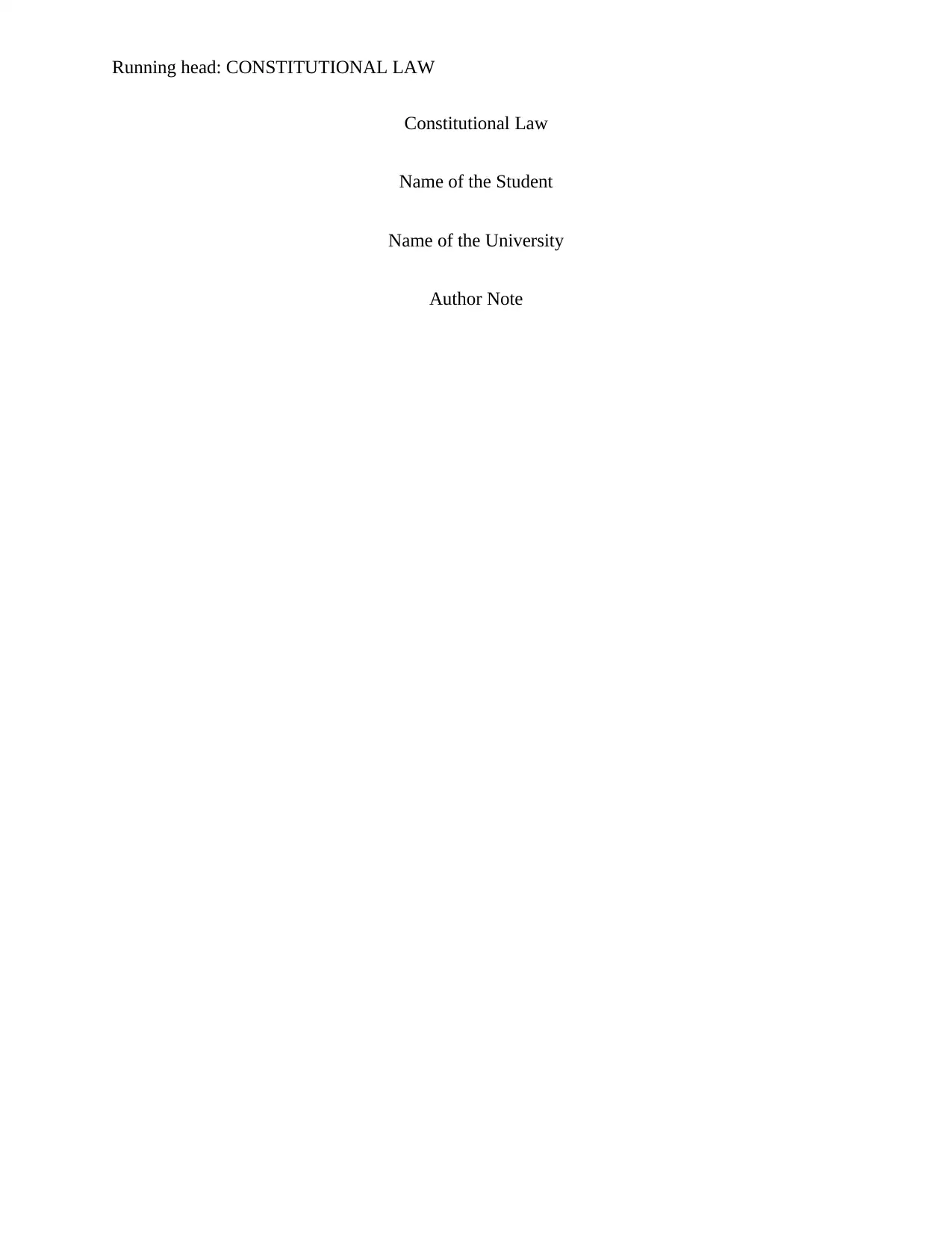
Running head: CONSTITUTIONAL LAW
Constitutional Law
Name of the Student
Name of the University
Author Note
Constitutional Law
Name of the Student
Name of the University
Author Note
Secure Best Marks with AI Grader
Need help grading? Try our AI Grader for instant feedback on your assignments.
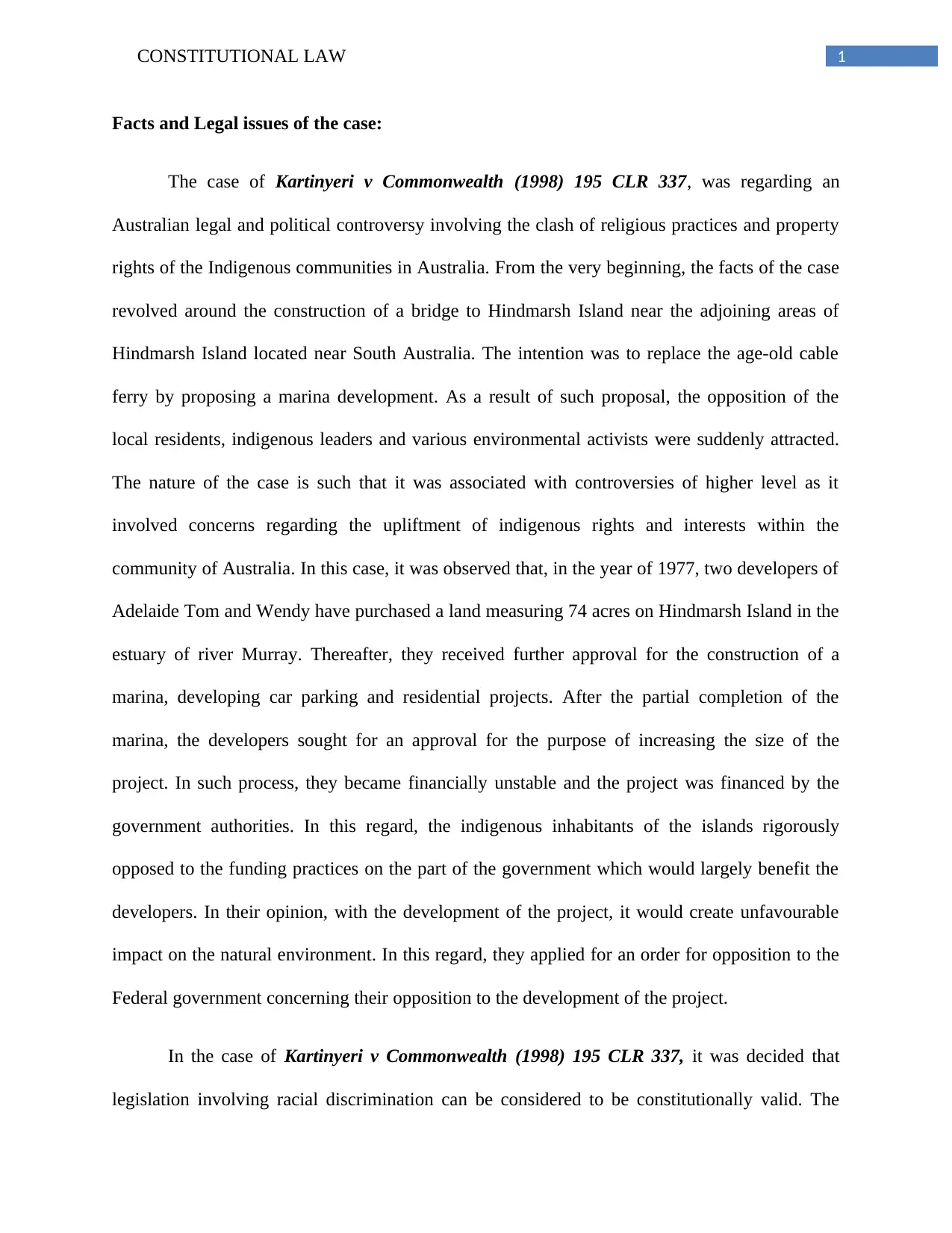
1CONSTITUTIONAL LAW
Facts and Legal issues of the case:
The case of Kartinyeri v Commonwealth (1998) 195 CLR 337, was regarding an
Australian legal and political controversy involving the clash of religious practices and property
rights of the Indigenous communities in Australia. From the very beginning, the facts of the case
revolved around the construction of a bridge to Hindmarsh Island near the adjoining areas of
Hindmarsh Island located near South Australia. The intention was to replace the age-old cable
ferry by proposing a marina development. As a result of such proposal, the opposition of the
local residents, indigenous leaders and various environmental activists were suddenly attracted.
The nature of the case is such that it was associated with controversies of higher level as it
involved concerns regarding the upliftment of indigenous rights and interests within the
community of Australia. In this case, it was observed that, in the year of 1977, two developers of
Adelaide Tom and Wendy have purchased a land measuring 74 acres on Hindmarsh Island in the
estuary of river Murray. Thereafter, they received further approval for the construction of a
marina, developing car parking and residential projects. After the partial completion of the
marina, the developers sought for an approval for the purpose of increasing the size of the
project. In such process, they became financially unstable and the project was financed by the
government authorities. In this regard, the indigenous inhabitants of the islands rigorously
opposed to the funding practices on the part of the government which would largely benefit the
developers. In their opinion, with the development of the project, it would create unfavourable
impact on the natural environment. In this regard, they applied for an order for opposition to the
Federal government concerning their opposition to the development of the project.
In the case of Kartinyeri v Commonwealth (1998) 195 CLR 337, it was decided that
legislation involving racial discrimination can be considered to be constitutionally valid. The
Facts and Legal issues of the case:
The case of Kartinyeri v Commonwealth (1998) 195 CLR 337, was regarding an
Australian legal and political controversy involving the clash of religious practices and property
rights of the Indigenous communities in Australia. From the very beginning, the facts of the case
revolved around the construction of a bridge to Hindmarsh Island near the adjoining areas of
Hindmarsh Island located near South Australia. The intention was to replace the age-old cable
ferry by proposing a marina development. As a result of such proposal, the opposition of the
local residents, indigenous leaders and various environmental activists were suddenly attracted.
The nature of the case is such that it was associated with controversies of higher level as it
involved concerns regarding the upliftment of indigenous rights and interests within the
community of Australia. In this case, it was observed that, in the year of 1977, two developers of
Adelaide Tom and Wendy have purchased a land measuring 74 acres on Hindmarsh Island in the
estuary of river Murray. Thereafter, they received further approval for the construction of a
marina, developing car parking and residential projects. After the partial completion of the
marina, the developers sought for an approval for the purpose of increasing the size of the
project. In such process, they became financially unstable and the project was financed by the
government authorities. In this regard, the indigenous inhabitants of the islands rigorously
opposed to the funding practices on the part of the government which would largely benefit the
developers. In their opinion, with the development of the project, it would create unfavourable
impact on the natural environment. In this regard, they applied for an order for opposition to the
Federal government concerning their opposition to the development of the project.
In the case of Kartinyeri v Commonwealth (1998) 195 CLR 337, it was decided that
legislation involving racial discrimination can be considered to be constitutionally valid. The
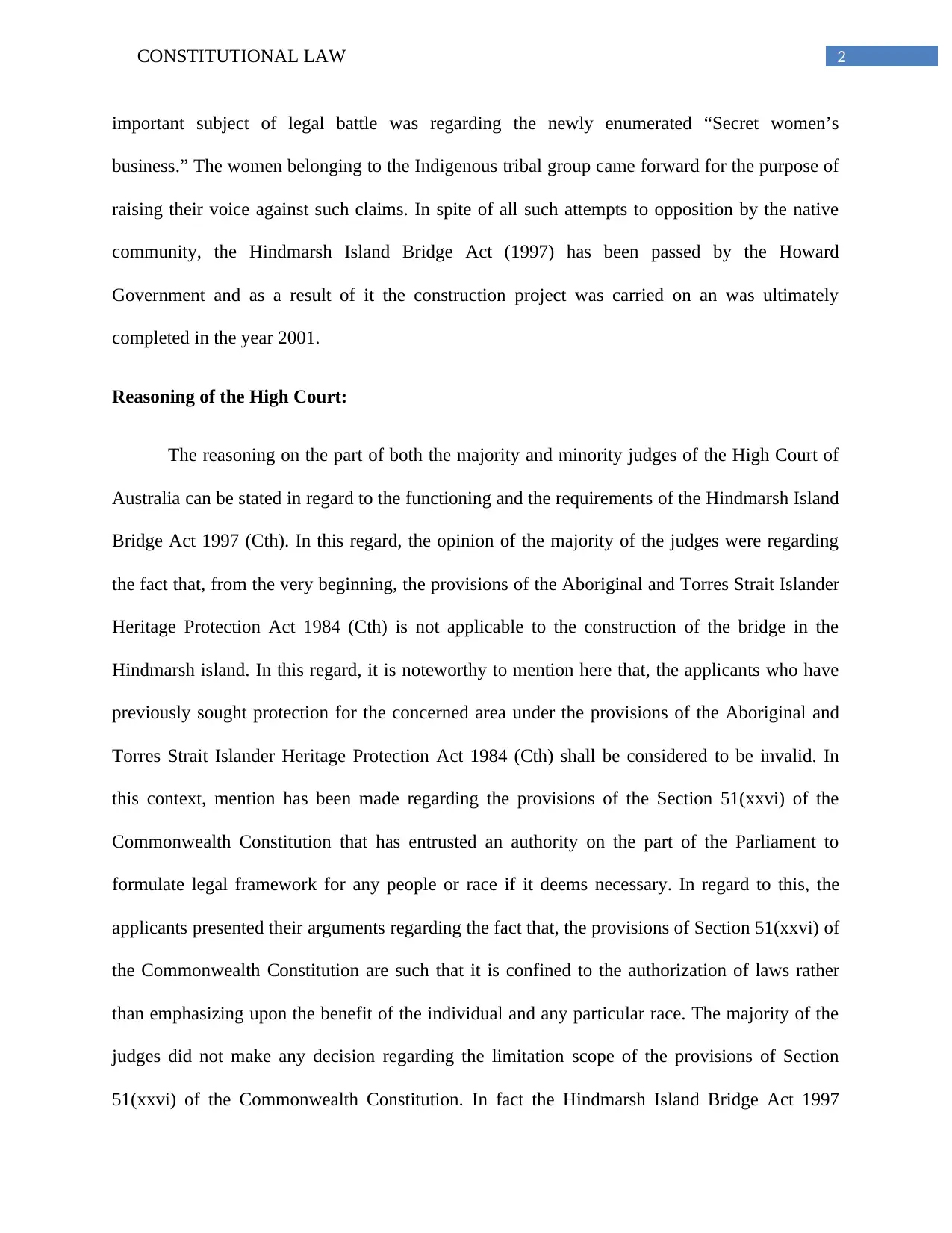
2CONSTITUTIONAL LAW
important subject of legal battle was regarding the newly enumerated “Secret women’s
business.” The women belonging to the Indigenous tribal group came forward for the purpose of
raising their voice against such claims. In spite of all such attempts to opposition by the native
community, the Hindmarsh Island Bridge Act (1997) has been passed by the Howard
Government and as a result of it the construction project was carried on an was ultimately
completed in the year 2001.
Reasoning of the High Court:
The reasoning on the part of both the majority and minority judges of the High Court of
Australia can be stated in regard to the functioning and the requirements of the Hindmarsh Island
Bridge Act 1997 (Cth). In this regard, the opinion of the majority of the judges were regarding
the fact that, from the very beginning, the provisions of the Aboriginal and Torres Strait Islander
Heritage Protection Act 1984 (Cth) is not applicable to the construction of the bridge in the
Hindmarsh island. In this regard, it is noteworthy to mention here that, the applicants who have
previously sought protection for the concerned area under the provisions of the Aboriginal and
Torres Strait Islander Heritage Protection Act 1984 (Cth) shall be considered to be invalid. In
this context, mention has been made regarding the provisions of the Section 51(xxvi) of the
Commonwealth Constitution that has entrusted an authority on the part of the Parliament to
formulate legal framework for any people or race if it deems necessary. In regard to this, the
applicants presented their arguments regarding the fact that, the provisions of Section 51(xxvi) of
the Commonwealth Constitution are such that it is confined to the authorization of laws rather
than emphasizing upon the benefit of the individual and any particular race. The majority of the
judges did not make any decision regarding the limitation scope of the provisions of Section
51(xxvi) of the Commonwealth Constitution. In fact the Hindmarsh Island Bridge Act 1997
important subject of legal battle was regarding the newly enumerated “Secret women’s
business.” The women belonging to the Indigenous tribal group came forward for the purpose of
raising their voice against such claims. In spite of all such attempts to opposition by the native
community, the Hindmarsh Island Bridge Act (1997) has been passed by the Howard
Government and as a result of it the construction project was carried on an was ultimately
completed in the year 2001.
Reasoning of the High Court:
The reasoning on the part of both the majority and minority judges of the High Court of
Australia can be stated in regard to the functioning and the requirements of the Hindmarsh Island
Bridge Act 1997 (Cth). In this regard, the opinion of the majority of the judges were regarding
the fact that, from the very beginning, the provisions of the Aboriginal and Torres Strait Islander
Heritage Protection Act 1984 (Cth) is not applicable to the construction of the bridge in the
Hindmarsh island. In this regard, it is noteworthy to mention here that, the applicants who have
previously sought protection for the concerned area under the provisions of the Aboriginal and
Torres Strait Islander Heritage Protection Act 1984 (Cth) shall be considered to be invalid. In
this context, mention has been made regarding the provisions of the Section 51(xxvi) of the
Commonwealth Constitution that has entrusted an authority on the part of the Parliament to
formulate legal framework for any people or race if it deems necessary. In regard to this, the
applicants presented their arguments regarding the fact that, the provisions of Section 51(xxvi) of
the Commonwealth Constitution are such that it is confined to the authorization of laws rather
than emphasizing upon the benefit of the individual and any particular race. The majority of the
judges did not make any decision regarding the limitation scope of the provisions of Section
51(xxvi) of the Commonwealth Constitution. In fact the Hindmarsh Island Bridge Act 1997
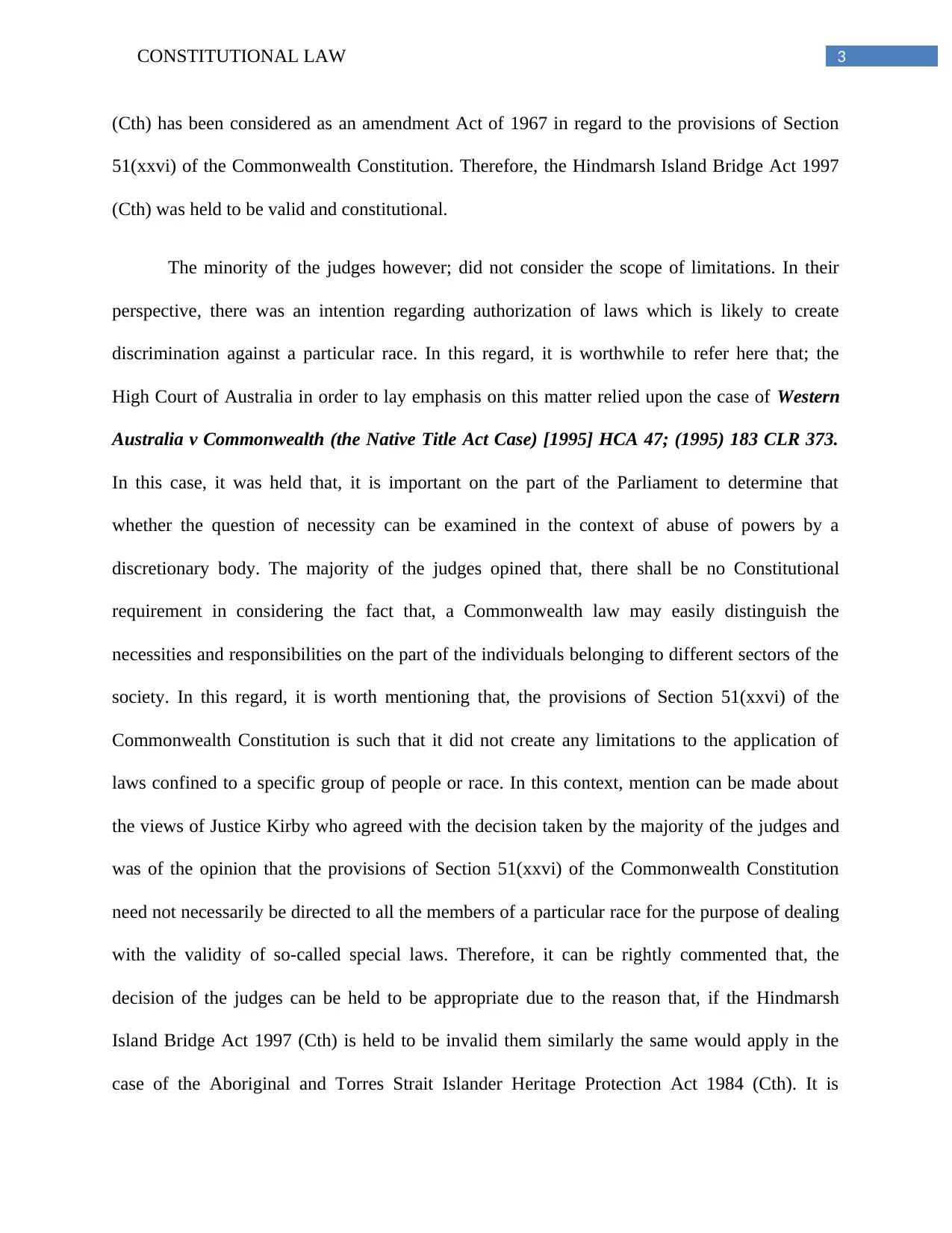
3CONSTITUTIONAL LAW
(Cth) has been considered as an amendment Act of 1967 in regard to the provisions of Section
51(xxvi) of the Commonwealth Constitution. Therefore, the Hindmarsh Island Bridge Act 1997
(Cth) was held to be valid and constitutional.
The minority of the judges however; did not consider the scope of limitations. In their
perspective, there was an intention regarding authorization of laws which is likely to create
discrimination against a particular race. In this regard, it is worthwhile to refer here that; the
High Court of Australia in order to lay emphasis on this matter relied upon the case of Western
Australia v Commonwealth (the Native Title Act Case) [1995] HCA 47; (1995) 183 CLR 373.
In this case, it was held that, it is important on the part of the Parliament to determine that
whether the question of necessity can be examined in the context of abuse of powers by a
discretionary body. The majority of the judges opined that, there shall be no Constitutional
requirement in considering the fact that, a Commonwealth law may easily distinguish the
necessities and responsibilities on the part of the individuals belonging to different sectors of the
society. In this regard, it is worth mentioning that, the provisions of Section 51(xxvi) of the
Commonwealth Constitution is such that it did not create any limitations to the application of
laws confined to a specific group of people or race. In this context, mention can be made about
the views of Justice Kirby who agreed with the decision taken by the majority of the judges and
was of the opinion that the provisions of Section 51(xxvi) of the Commonwealth Constitution
need not necessarily be directed to all the members of a particular race for the purpose of dealing
with the validity of so-called special laws. Therefore, it can be rightly commented that, the
decision of the judges can be held to be appropriate due to the reason that, if the Hindmarsh
Island Bridge Act 1997 (Cth) is held to be invalid them similarly the same would apply in the
case of the Aboriginal and Torres Strait Islander Heritage Protection Act 1984 (Cth). It is
(Cth) has been considered as an amendment Act of 1967 in regard to the provisions of Section
51(xxvi) of the Commonwealth Constitution. Therefore, the Hindmarsh Island Bridge Act 1997
(Cth) was held to be valid and constitutional.
The minority of the judges however; did not consider the scope of limitations. In their
perspective, there was an intention regarding authorization of laws which is likely to create
discrimination against a particular race. In this regard, it is worthwhile to refer here that; the
High Court of Australia in order to lay emphasis on this matter relied upon the case of Western
Australia v Commonwealth (the Native Title Act Case) [1995] HCA 47; (1995) 183 CLR 373.
In this case, it was held that, it is important on the part of the Parliament to determine that
whether the question of necessity can be examined in the context of abuse of powers by a
discretionary body. The majority of the judges opined that, there shall be no Constitutional
requirement in considering the fact that, a Commonwealth law may easily distinguish the
necessities and responsibilities on the part of the individuals belonging to different sectors of the
society. In this regard, it is worth mentioning that, the provisions of Section 51(xxvi) of the
Commonwealth Constitution is such that it did not create any limitations to the application of
laws confined to a specific group of people or race. In this context, mention can be made about
the views of Justice Kirby who agreed with the decision taken by the majority of the judges and
was of the opinion that the provisions of Section 51(xxvi) of the Commonwealth Constitution
need not necessarily be directed to all the members of a particular race for the purpose of dealing
with the validity of so-called special laws. Therefore, it can be rightly commented that, the
decision of the judges can be held to be appropriate due to the reason that, if the Hindmarsh
Island Bridge Act 1997 (Cth) is held to be invalid them similarly the same would apply in the
case of the Aboriginal and Torres Strait Islander Heritage Protection Act 1984 (Cth). It is
Secure Best Marks with AI Grader
Need help grading? Try our AI Grader for instant feedback on your assignments.
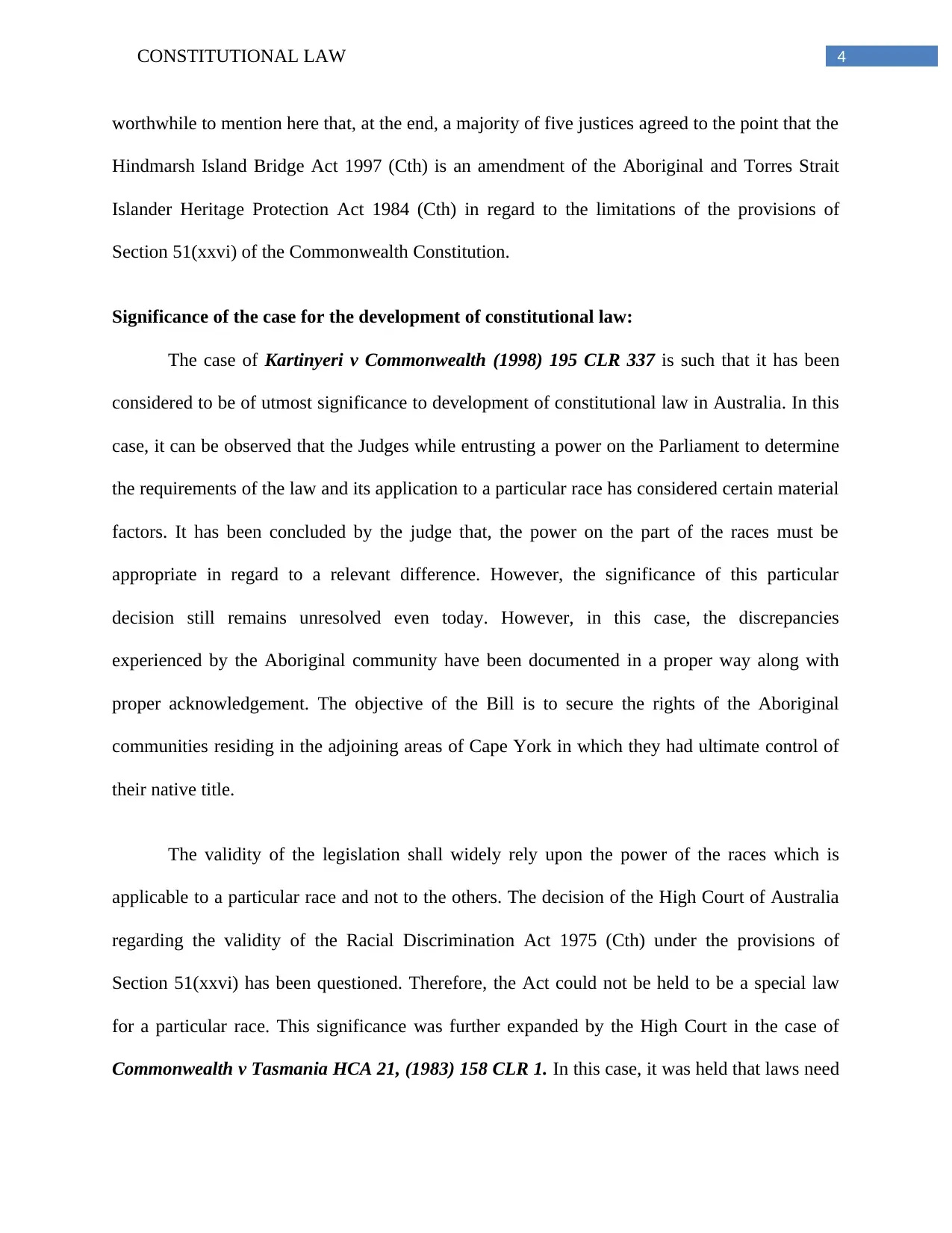
4CONSTITUTIONAL LAW
worthwhile to mention here that, at the end, a majority of five justices agreed to the point that the
Hindmarsh Island Bridge Act 1997 (Cth) is an amendment of the Aboriginal and Torres Strait
Islander Heritage Protection Act 1984 (Cth) in regard to the limitations of the provisions of
Section 51(xxvi) of the Commonwealth Constitution.
Significance of the case for the development of constitutional law:
The case of Kartinyeri v Commonwealth (1998) 195 CLR 337 is such that it has been
considered to be of utmost significance to development of constitutional law in Australia. In this
case, it can be observed that the Judges while entrusting a power on the Parliament to determine
the requirements of the law and its application to a particular race has considered certain material
factors. It has been concluded by the judge that, the power on the part of the races must be
appropriate in regard to a relevant difference. However, the significance of this particular
decision still remains unresolved even today. However, in this case, the discrepancies
experienced by the Aboriginal community have been documented in a proper way along with
proper acknowledgement. The objective of the Bill is to secure the rights of the Aboriginal
communities residing in the adjoining areas of Cape York in which they had ultimate control of
their native title.
The validity of the legislation shall widely rely upon the power of the races which is
applicable to a particular race and not to the others. The decision of the High Court of Australia
regarding the validity of the Racial Discrimination Act 1975 (Cth) under the provisions of
Section 51(xxvi) has been questioned. Therefore, the Act could not be held to be a special law
for a particular race. This significance was further expanded by the High Court in the case of
Commonwealth v Tasmania HCA 21, (1983) 158 CLR 1. In this case, it was held that laws need
worthwhile to mention here that, at the end, a majority of five justices agreed to the point that the
Hindmarsh Island Bridge Act 1997 (Cth) is an amendment of the Aboriginal and Torres Strait
Islander Heritage Protection Act 1984 (Cth) in regard to the limitations of the provisions of
Section 51(xxvi) of the Commonwealth Constitution.
Significance of the case for the development of constitutional law:
The case of Kartinyeri v Commonwealth (1998) 195 CLR 337 is such that it has been
considered to be of utmost significance to development of constitutional law in Australia. In this
case, it can be observed that the Judges while entrusting a power on the Parliament to determine
the requirements of the law and its application to a particular race has considered certain material
factors. It has been concluded by the judge that, the power on the part of the races must be
appropriate in regard to a relevant difference. However, the significance of this particular
decision still remains unresolved even today. However, in this case, the discrepancies
experienced by the Aboriginal community have been documented in a proper way along with
proper acknowledgement. The objective of the Bill is to secure the rights of the Aboriginal
communities residing in the adjoining areas of Cape York in which they had ultimate control of
their native title.
The validity of the legislation shall widely rely upon the power of the races which is
applicable to a particular race and not to the others. The decision of the High Court of Australia
regarding the validity of the Racial Discrimination Act 1975 (Cth) under the provisions of
Section 51(xxvi) has been questioned. Therefore, the Act could not be held to be a special law
for a particular race. This significance was further expanded by the High Court in the case of
Commonwealth v Tasmania HCA 21, (1983) 158 CLR 1. In this case, it was held that laws need
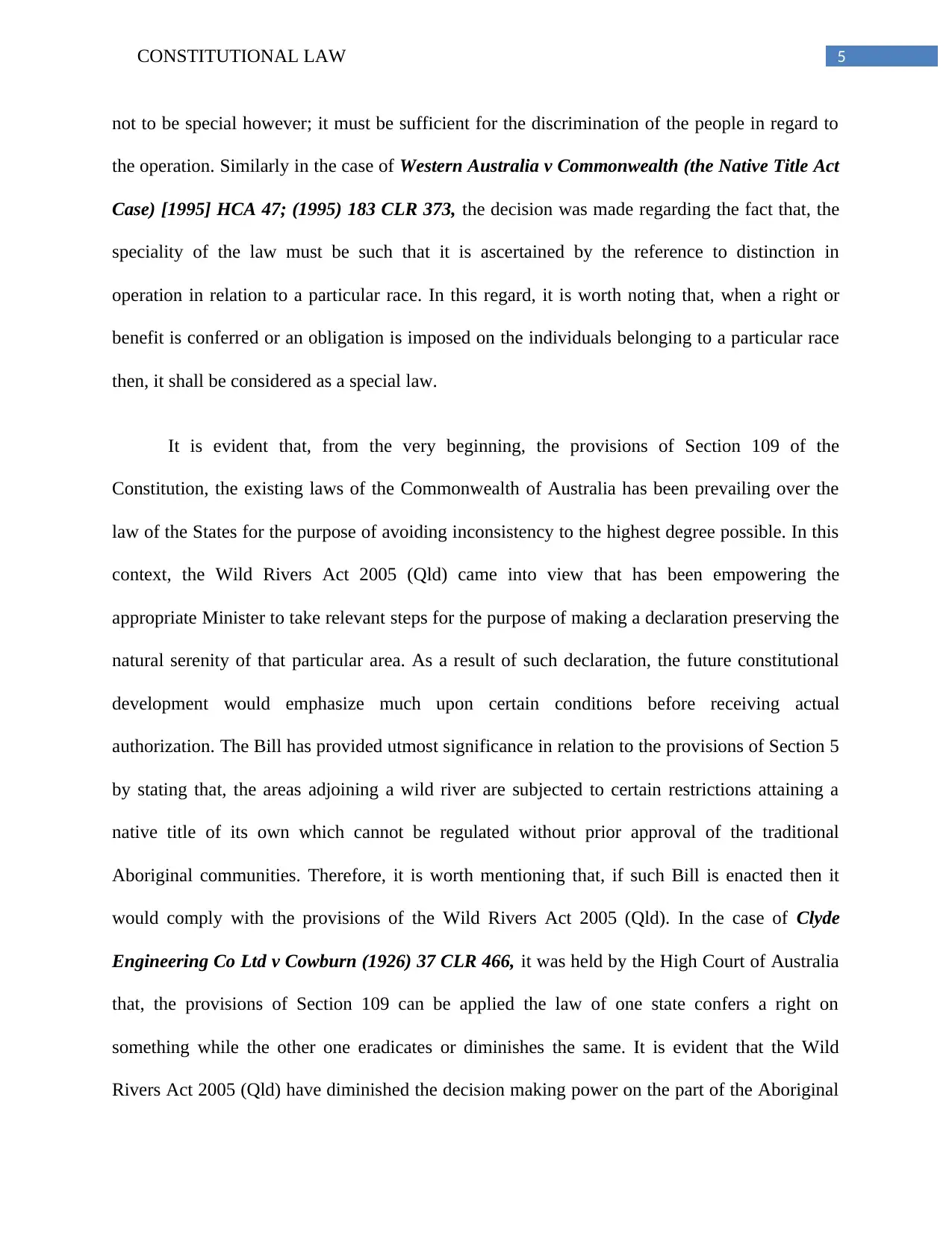
5CONSTITUTIONAL LAW
not to be special however; it must be sufficient for the discrimination of the people in regard to
the operation. Similarly in the case of Western Australia v Commonwealth (the Native Title Act
Case) [1995] HCA 47; (1995) 183 CLR 373, the decision was made regarding the fact that, the
speciality of the law must be such that it is ascertained by the reference to distinction in
operation in relation to a particular race. In this regard, it is worth noting that, when a right or
benefit is conferred or an obligation is imposed on the individuals belonging to a particular race
then, it shall be considered as a special law.
It is evident that, from the very beginning, the provisions of Section 109 of the
Constitution, the existing laws of the Commonwealth of Australia has been prevailing over the
law of the States for the purpose of avoiding inconsistency to the highest degree possible. In this
context, the Wild Rivers Act 2005 (Qld) came into view that has been empowering the
appropriate Minister to take relevant steps for the purpose of making a declaration preserving the
natural serenity of that particular area. As a result of such declaration, the future constitutional
development would emphasize much upon certain conditions before receiving actual
authorization. The Bill has provided utmost significance in relation to the provisions of Section 5
by stating that, the areas adjoining a wild river are subjected to certain restrictions attaining a
native title of its own which cannot be regulated without prior approval of the traditional
Aboriginal communities. Therefore, it is worth mentioning that, if such Bill is enacted then it
would comply with the provisions of the Wild Rivers Act 2005 (Qld). In the case of Clyde
Engineering Co Ltd v Cowburn (1926) 37 CLR 466, it was held by the High Court of Australia
that, the provisions of Section 109 can be applied the law of one state confers a right on
something while the other one eradicates or diminishes the same. It is evident that the Wild
Rivers Act 2005 (Qld) have diminished the decision making power on the part of the Aboriginal
not to be special however; it must be sufficient for the discrimination of the people in regard to
the operation. Similarly in the case of Western Australia v Commonwealth (the Native Title Act
Case) [1995] HCA 47; (1995) 183 CLR 373, the decision was made regarding the fact that, the
speciality of the law must be such that it is ascertained by the reference to distinction in
operation in relation to a particular race. In this regard, it is worth noting that, when a right or
benefit is conferred or an obligation is imposed on the individuals belonging to a particular race
then, it shall be considered as a special law.
It is evident that, from the very beginning, the provisions of Section 109 of the
Constitution, the existing laws of the Commonwealth of Australia has been prevailing over the
law of the States for the purpose of avoiding inconsistency to the highest degree possible. In this
context, the Wild Rivers Act 2005 (Qld) came into view that has been empowering the
appropriate Minister to take relevant steps for the purpose of making a declaration preserving the
natural serenity of that particular area. As a result of such declaration, the future constitutional
development would emphasize much upon certain conditions before receiving actual
authorization. The Bill has provided utmost significance in relation to the provisions of Section 5
by stating that, the areas adjoining a wild river are subjected to certain restrictions attaining a
native title of its own which cannot be regulated without prior approval of the traditional
Aboriginal communities. Therefore, it is worth mentioning that, if such Bill is enacted then it
would comply with the provisions of the Wild Rivers Act 2005 (Qld). In the case of Clyde
Engineering Co Ltd v Cowburn (1926) 37 CLR 466, it was held by the High Court of Australia
that, the provisions of Section 109 can be applied the law of one state confers a right on
something while the other one eradicates or diminishes the same. It is evident that the Wild
Rivers Act 2005 (Qld) have diminished the decision making power on the part of the Aboriginal
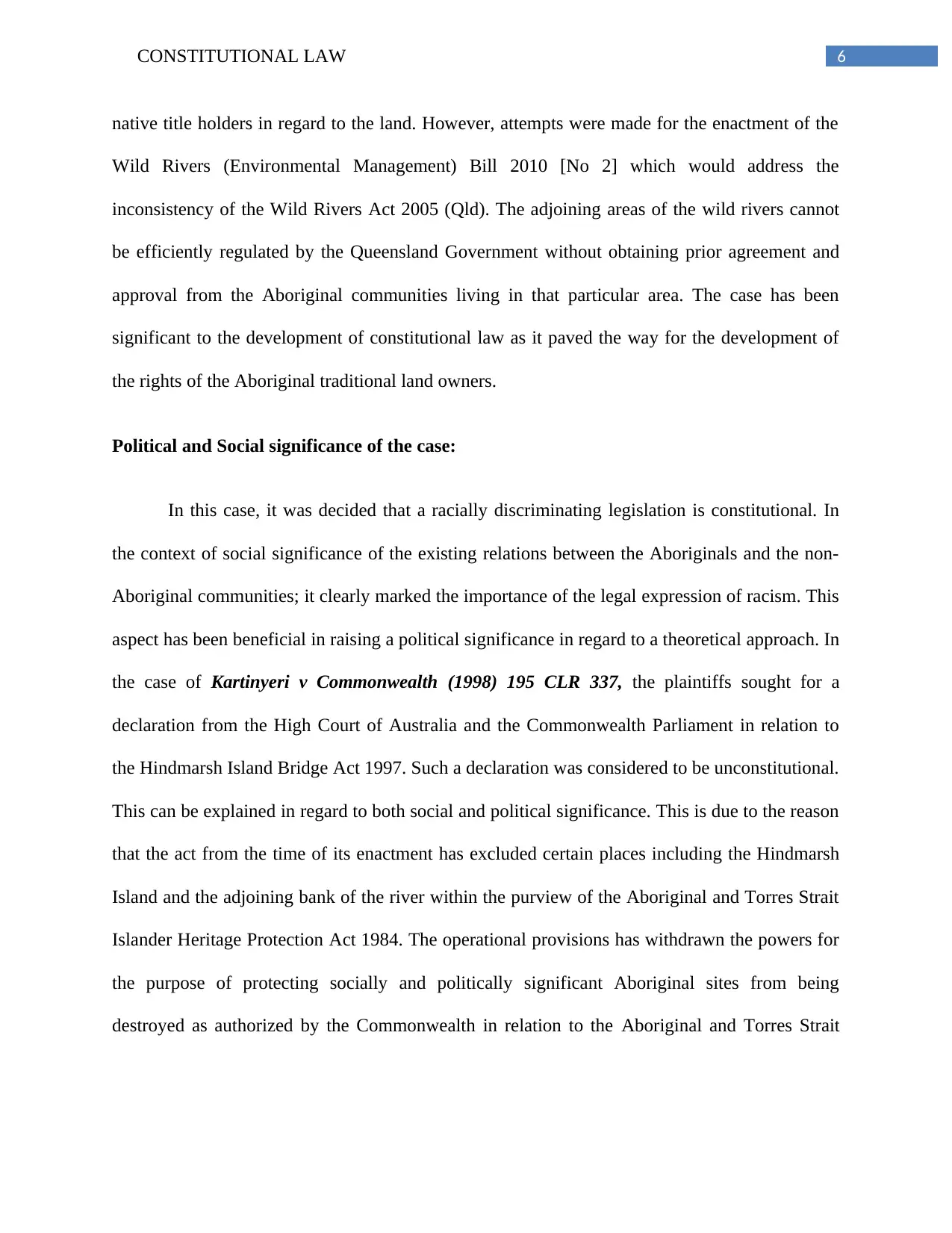
6CONSTITUTIONAL LAW
native title holders in regard to the land. However, attempts were made for the enactment of the
Wild Rivers (Environmental Management) Bill 2010 [No 2] which would address the
inconsistency of the Wild Rivers Act 2005 (Qld). The adjoining areas of the wild rivers cannot
be efficiently regulated by the Queensland Government without obtaining prior agreement and
approval from the Aboriginal communities living in that particular area. The case has been
significant to the development of constitutional law as it paved the way for the development of
the rights of the Aboriginal traditional land owners.
Political and Social significance of the case:
In this case, it was decided that a racially discriminating legislation is constitutional. In
the context of social significance of the existing relations between the Aboriginals and the non-
Aboriginal communities; it clearly marked the importance of the legal expression of racism. This
aspect has been beneficial in raising a political significance in regard to a theoretical approach. In
the case of Kartinyeri v Commonwealth (1998) 195 CLR 337, the plaintiffs sought for a
declaration from the High Court of Australia and the Commonwealth Parliament in relation to
the Hindmarsh Island Bridge Act 1997. Such a declaration was considered to be unconstitutional.
This can be explained in regard to both social and political significance. This is due to the reason
that the act from the time of its enactment has excluded certain places including the Hindmarsh
Island and the adjoining bank of the river within the purview of the Aboriginal and Torres Strait
Islander Heritage Protection Act 1984. The operational provisions has withdrawn the powers for
the purpose of protecting socially and politically significant Aboriginal sites from being
destroyed as authorized by the Commonwealth in relation to the Aboriginal and Torres Strait
native title holders in regard to the land. However, attempts were made for the enactment of the
Wild Rivers (Environmental Management) Bill 2010 [No 2] which would address the
inconsistency of the Wild Rivers Act 2005 (Qld). The adjoining areas of the wild rivers cannot
be efficiently regulated by the Queensland Government without obtaining prior agreement and
approval from the Aboriginal communities living in that particular area. The case has been
significant to the development of constitutional law as it paved the way for the development of
the rights of the Aboriginal traditional land owners.
Political and Social significance of the case:
In this case, it was decided that a racially discriminating legislation is constitutional. In
the context of social significance of the existing relations between the Aboriginals and the non-
Aboriginal communities; it clearly marked the importance of the legal expression of racism. This
aspect has been beneficial in raising a political significance in regard to a theoretical approach. In
the case of Kartinyeri v Commonwealth (1998) 195 CLR 337, the plaintiffs sought for a
declaration from the High Court of Australia and the Commonwealth Parliament in relation to
the Hindmarsh Island Bridge Act 1997. Such a declaration was considered to be unconstitutional.
This can be explained in regard to both social and political significance. This is due to the reason
that the act from the time of its enactment has excluded certain places including the Hindmarsh
Island and the adjoining bank of the river within the purview of the Aboriginal and Torres Strait
Islander Heritage Protection Act 1984. The operational provisions has withdrawn the powers for
the purpose of protecting socially and politically significant Aboriginal sites from being
destroyed as authorized by the Commonwealth in relation to the Aboriginal and Torres Strait
Paraphrase This Document
Need a fresh take? Get an instant paraphrase of this document with our AI Paraphraser

7CONSTITUTIONAL LAW
Islander Heritage Protection Act 1984 (Cth). The considerable effects were to withdraw certain
community procedural rights from the plaintiffs for the protection of their heritage sites.
Islander Heritage Protection Act 1984 (Cth). The considerable effects were to withdraw certain
community procedural rights from the plaintiffs for the protection of their heritage sites.
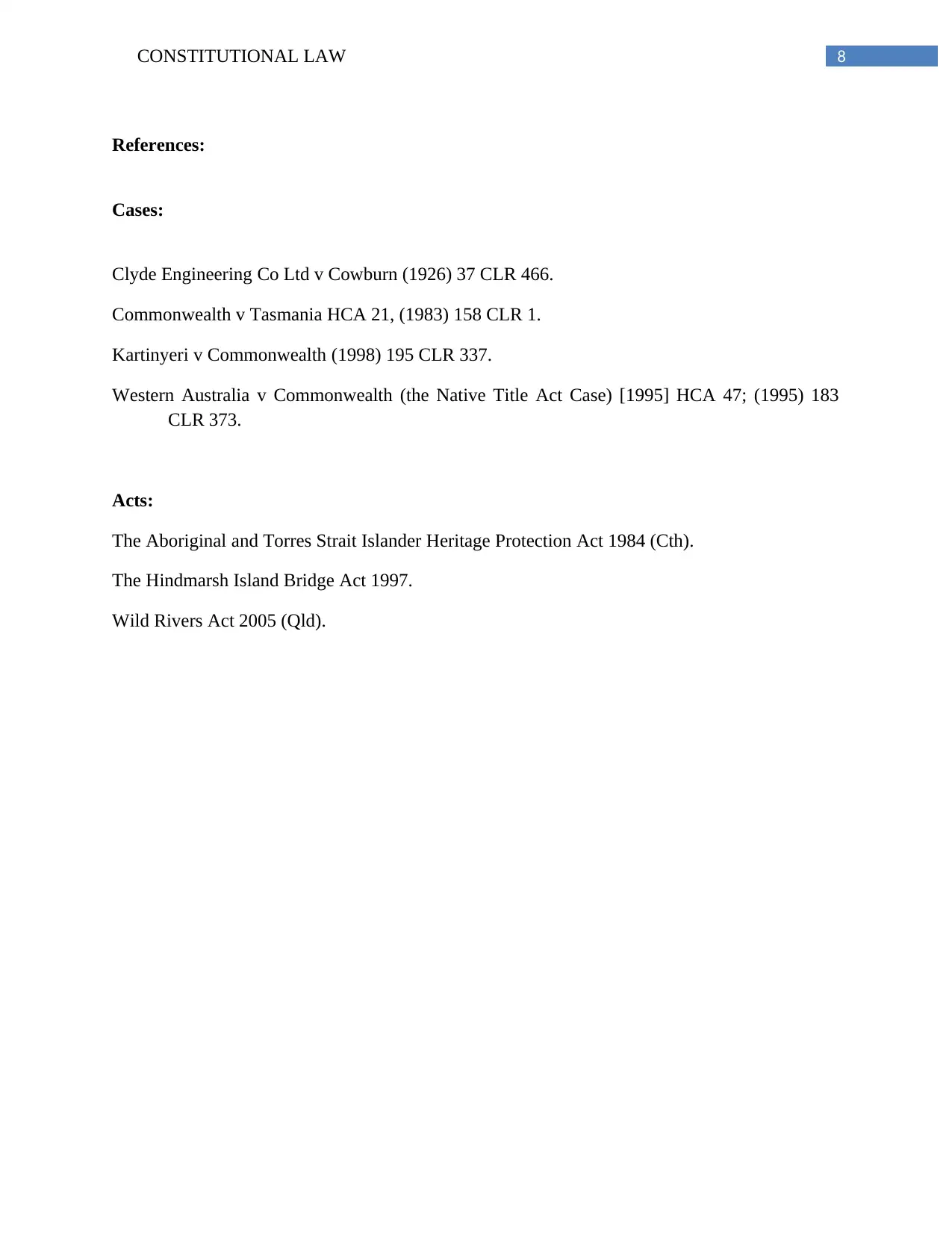
8CONSTITUTIONAL LAW
References:
Cases:
Clyde Engineering Co Ltd v Cowburn (1926) 37 CLR 466.
Commonwealth v Tasmania HCA 21, (1983) 158 CLR 1.
Kartinyeri v Commonwealth (1998) 195 CLR 337.
Western Australia v Commonwealth (the Native Title Act Case) [1995] HCA 47; (1995) 183
CLR 373.
Acts:
The Aboriginal and Torres Strait Islander Heritage Protection Act 1984 (Cth).
The Hindmarsh Island Bridge Act 1997.
Wild Rivers Act 2005 (Qld).
References:
Cases:
Clyde Engineering Co Ltd v Cowburn (1926) 37 CLR 466.
Commonwealth v Tasmania HCA 21, (1983) 158 CLR 1.
Kartinyeri v Commonwealth (1998) 195 CLR 337.
Western Australia v Commonwealth (the Native Title Act Case) [1995] HCA 47; (1995) 183
CLR 373.
Acts:
The Aboriginal and Torres Strait Islander Heritage Protection Act 1984 (Cth).
The Hindmarsh Island Bridge Act 1997.
Wild Rivers Act 2005 (Qld).
1 out of 9
Your All-in-One AI-Powered Toolkit for Academic Success.
+13062052269
info@desklib.com
Available 24*7 on WhatsApp / Email
![[object Object]](/_next/static/media/star-bottom.7253800d.svg)
Unlock your academic potential
© 2024 | Zucol Services PVT LTD | All rights reserved.

